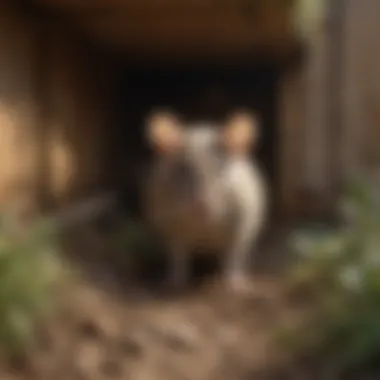Comprehensive Guide to Dealing with Outdoor Rat Problems: Insightful Solutions


Preventive Pest Control Strategies
As an essential aspect of maintaining a pest-free outdoor environment, preventive pest control strategies are crucial for minimizing the risk of rat infestations. Starting with house exterior protection, it is imperative to seal any cracks or openings that could serve as entry points for rodents. Additionally, clearing debris and clutter around your property helps prevent pests from finding hiding spots. When it comes to yard maintenance, regular care routines such as mowing the lawn, trimming bushes, and eliminating standing water can significantly reduce the attractiveness of your yard to rodents and other pests. By creating a well-maintained outdoor space, you make it less hospitable for unwanted critters. Indoor cleanliness also plays a vital role in pest prevention. Expert cleaning tips and techniques advocate for a clutter-free indoor environment, proper food storage, and regular vacuuming to deter pests from settling in your home. Maintaining sanitation indoors goes a long way in reducing the likelihood of infestations. Furthermore, efficient garbage disposal methods are essential in keeping pests away. Proper waste management not only reduces odors that attract rats but also eliminates potential food sources for them. Emphasizing the importance of proper garbage disposal helps homeowners grasp the significance of keeping their surroundings clean. Lastly, incorporating innovative pest prevention strategies provides an extra layer of defense against unwanted invaders. Whether it's using natural repellents, installing motion-activated lighting, or sealing off potential entry points, thinking outside the box can enhance your overall pest control efforts.
Understanding Outdoor Rat Behavior
In the realm of dealing with outdoor rat problems, understanding the behavior of these rodents is paramount. This section delves into the intricate workings of rat behavior, shedding light on their habits and movement patterns to equip readers with knowledge crucial for effective rat control strategies. By grasping the underlying reasons behind rat actions, individuals can adopt targeted approaches that disrupt rat activities and minimize infestations. The significance of comprehending outdoor rat behavior lies in its ability to serve as a foundation for devising preventative measures and eradication methods tailored to the specific tendencies of these pests.
Rat Habits and Nesting Sites
Identification of Common Nesting Sites
The identification of common nesting sites plays a crucial role in mitigating outdoor rat issues. By pinpointing areas where rats prefer to establish their nests, individuals can target these locations to disrupt rat populations and prevent further infestations. Common nesting sites include dark, secluded areas such as spaces beneath porches, in wall voids, or within overgrown vegetation. These sites provide rats with the seclusion and protection essential for breeding and establishing colonies. Understanding these preferred nesting locations enables individuals to conduct thorough inspections, identify potential rat habitats, and implement proactive measures to deter rats from settling in these areas.
Factors Attracting Rats to Outdoor Spaces
Factors that attract rats to outdoor spaces are key considerations when developing rat control strategies. Rats are drawn to areas with easily accessible food sources, water supply, and shelter. By addressing these attractants, individuals can modify the environment to make it less hospitable for rats. Common attractants include unsecured garbage bins, bird feeders, pet food left outdoors, and cluttered yards with ample hiding spots. Awareness of these factors allows individuals to make informed decisions on reducing attractants, thereby discouraging rat activity and decreasing the likelihood of infestations.
Rat Movement Patterns
Routes Rats Take to Access Food Sources
Understanding the routes rats take to access food sources is integral to curtailing their foraging activities. Rats navigate outdoor spaces through established pathways that lead them to food reservoirs. By identifying these routes, individuals can strategically place deterrents or traps along rat highways, disrupting their movements and intercepting their access to sustenance. Recognizing the patterns rats follow in search of food empowers individuals to disrupt these paths, creating barriers that impede rat movements and reduce their ability to forage efficiently.
Nocturnal Behavior of Rats


The nocturnal behavior of rats significantly impacts control measures aimed at managing outdoor rat populations. Rats are predominantly active during the night, utilizing darkness and reduced human activity to roam outdoor spaces undetected. Their nocturnal habits not only make them elusive targets but also complicate monitoring and control efforts. Understanding the nocturnal behavior of rats is essential for implementing control strategies tailored to their activity patterns. By considering their behavior during nighttime hours, individuals can optimize trap placement, baiting strategies, and surveillance techniques to enhance efficacy and capture rates.
Signs of Outdoor Rat Infestations
When it comes to dealing with outdoor rat problems, understanding the signs of rat infestations is crucial for effective pest management. Recognizing these signs early can help prevent extensive property damage and health risks associated with rats. In this section, we will delve into the visual indications that signal a rat presence, focusing on droppings, gnaw marks, burrows, and runways.
Visual Indications
Droppings and Gnaw Marks
Droppings and gnaw marks are some of the most common visual signs of a rat infestation. Rat droppings are typically small, dark pellets and are often found near food sources or along pathways that rats frequent. These droppings not only indicate the presence of rats but can also provide insights into the size and activity level of the infestation. On the other hand, gnaw marks on various surfaces, such as wood, plastic, or electrical wires, serve as evidence of rats' destructive chewing habits.
The significance of identifying droppings and gnaw marks lies in their ability to pinpoint areas of rat activity, allowing homeowners to take prompt action to control the infestation. By recognizing these visual cues, individuals can implement targeted eradication methods and preventive measures to deter rats from causing further damage.
Burrows and Runways
Burrows and runways are another set of visual indications of outdoor rat infestations. Rats are known to create burrows, which are tunnels dug into the ground for shelter and nesting. These burrows can often be found near garbage areas, beneath decks, or in overgrown vegetation. Rats also create runways along walls or fences, which are pathways they use to travel between their nest and food sources.
The presence of burrows and runways signifies an established rat population in the vicinity. Homeowners should pay close attention to these signs as they indicate a more advanced stage of infestation. By identifying and addressing burrows and runways promptly, individuals can prevent rats from reproducing and expanding their presence on the property.
Health Risks and Property Damage Caused by Rats
In this article, the topic of Health Risks and Property Damage Caused by Rats holds paramount importance as it delves into the detrimental effects that rat infestations can have on both human health and property integrity. Understanding the risks associated with rat-borne diseases and the structural harm inflicted by these rodents is crucial for creating effective strategies to combat outdoor rat problems.
Diseases Transmitted by Rats


List of Common Rat-Borne Illnesses
The List of Common Rat-Borne Illnesses is a critical aspect to be addressed in this article as it sheds light on the various diseases that rats can transmit to humans. Highlighting diseases such as leptospirosis, hantavirus, and rat-bite fever among others, provides insight into the potential health threats posed by rats. By understanding the symptoms and risks associated with each illness, readers can grasp the importance of rat control measures to prevent the spread of these diseases.
Impact on Human Health
Exploring the Impact on Human Health due to rat infestations is imperative in this article to emphasize the direct consequences on individuals. From mild symptoms to severe health complications, rat-borne illnesses can have a profound impact on human well-being. By elucidating the link between rat infestations and human health concerns, readers can grasp the urgent need for proactive rat control practices to safeguard their well-being.
Structural Harm Inflicted by Rats
Damage to Buildings and Wiring
Understanding the Damage to Buildings and Wiring caused by rats is vital as it addresses the physical harm rodents can inflict on properties. Rats gnawing on electrical wiring pose fire hazards, while their burrowing activities can compromise building structures. By outlining the extent of damage that rats can cause, readers gain a comprehensive understanding of the risks associated with rat infestations and the importance of prompt action to mitigate these risks.
Risk of Fire
The Risk of Fire stemming from rat activities is a crucial aspect to consider in this article as it underscores the potential dangers posed by unchecked rat infestations. Gnawed wires, nests in insulation, and flammable materials gathered by rats can all contribute to the risk of fire outbreaks in homes or commercial buildings. By drawing attention to this risk, readers can appreciate the urgency of addressing rat infestations to prevent potentially catastrophic fire incidents.
Preventive Measures for Outdoor Rat Control
In the realm of combating outdoor rat problems, preventive measures play a pivotal role in averting infestations before they escalate. Understanding the significance of preventive strategies is paramount in upholding a rat-free environment. This section delves into the proactive steps that individuals can take to minimize the risk of rat intrusions in outdoor spaces. By focusing on preemptive actions, such as environmental modifications and exclusion techniques, property owners can effectively mitigate the presence of rats and safeguard their surroundings.
Environmental Modifications
Securing Waste Disposal Areas


When addressing outdoor rat control, securing waste disposal areas emerges as a critical initiative. By effectively securing these spaces, individuals can restrict access to potential food sources that lure rats into the vicinity. The key aspect of securing waste disposal areas lies in implementing secure containers that are resistant to rodent infiltration. This measure proves to be highly beneficial within the context of this article by minimizing the availability of food for rats and thereby discouraging their presence. The unique feature of securing waste disposal areas lies in its ability to deny rats easy access to sustenance, consequently deterring them from frequenting the area. While this method is advantageous in controlling rat populations, individuals must remain vigilant in ensuring the continual maintenance and reinforcement of secured waste disposal areas to sustain its efficacy.
Reducing Food Sources
Another fundamental aspect of preventive rat control is reducing food sources that attract rats to outdoor settings. By minimizing or eliminating potential food supplies, individuals can create a less appealing environment for rats, deterring their entry and persistence. The primary characteristic of reducing food sources is the act of removing or securely storing items that are palatable to rats, such as uncovered garbage or leftover pet food. This strategy is popular within the context of this article due to its direct impact on rat behavior, disrupting their foraging patterns and diminishing their attraction to the area. The distinctive feature of reducing food sources lies in its ability to disrupt the food chain for rats, thereby forcing them to seek sustenance elsewhere. While beneficial, reducing food sources requires consistent adherence to best practices to ensure sustained results.
Exclusion Techniques
Sealing Entry Points
When considering exclusion techniques for outdoor rat control, sealing entry points stands out as a primary method of fortification against rat intrusion. By identifying and closing off potential entryways, individuals can effectively block rats from accessing indoor and outdoor spaces. The key characteristic of sealing entry points is its capability to act as a barrier, denying rats passage into structures or enclosed areas. This choice proves beneficial within the scope of this article by physically preventing rats from establishing nests or foraging within the premises. The unique feature of sealing entry points lies in its ability to fortify the integrity of buildings, safeguarding them against rat infestations. While advantageous, the proper application of sealing entry points necessitates thorough inspection and sealing of all vulnerable points to ensure comprehensive protection.
Installation of Rat Fences
Complementing the strategy of sealing entry points, the installation of rat fences reinforces the exclusionary measures for outdoor rat control. By erecting barriers that specifically deter rats, individuals can further enhance their property's defense against rodent encroachment. The key characteristic of installing rat fences is their ability to create a physical boundary that rats find challenging to breach, effectively confining them to external areas. This choice is popular in this article given its proactive approach to rat control, preemptively restricting rat movements and access. The unique feature of rat fences lies in their strategic placement that encloses outdoor spaces, forming a protective perimeter that dissuades rats from approaching inhabited areas. While beneficial, the installation of rat fences demands meticulous planning and construction to ensure that they serve their intended purpose effectively.
Effective Eradication Methods for Outdoor Rats
Effective eradication methods play a crucial role in managing outdoor rat problems effectively. In this comprehensive guide of Dealing with Outdoor Rat Problems, the section on effective eradication methods delves into essential strategies aimed at tackling rat infestations head-on. Understanding the significance of eradicating rats from outdoor spaces is paramount in ensuring the safety of both individuals and properties. By implementing targeted measures, individuals can take proactive steps to mitigate the risks posed by these pests.
Trapping and Baiting Strategies
Trapping and baiting are fundamental techniques in rat control, offering practical solutions to reduce rat populations in outdoor areas. When discussing types of rat traps, it is crucial to highlight the diversity of traps available, such as snap traps, glue traps, and live catch traps. Each type serves a specific purpose, targeting different rat species and infestation levels. Understanding the nuances of each trap type is essential in selecting the most suitable option for effectively capturing rats.
In terms of bait selection, the choice of bait can significantly impact the success of trapping efforts. Baits such as peanut butter, cheese, or fruits are commonly used to attract rats to traps. The type of bait selected should align with the preferences of the target rat species to ensure maximum effectiveness. Moreover, rotating bait options can help prevent bait shyness among rats, increasing the likelihood of successful trapping.
Professional Pest Control Services
When considering professional pest control services, individuals must assess the optimal timing for seeking expert intervention. Recognizing the limitations of DIY approaches in complex rat infestations is key to determining when professional help is necessary. Pest control experts possess specialized knowledge, tools, and resources to address challenging rat issues effectively.
The benefits of engaging pest control professionals extend beyond immediate eradication. Professionals not only provide comprehensive solutions but also offer long-term prevention strategies to safeguard properties from future infestations. Their experience in handling various rat scenarios equips them to devise tailored management plans that cater to specific needs and challenges homeowners may face.



